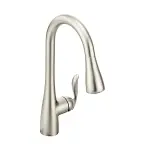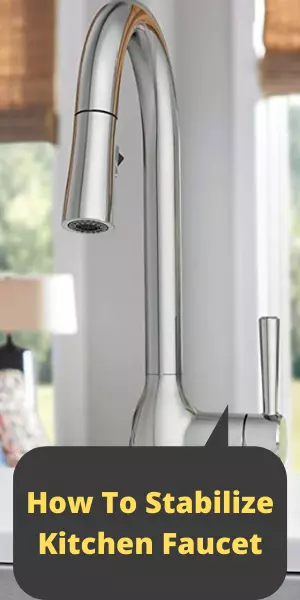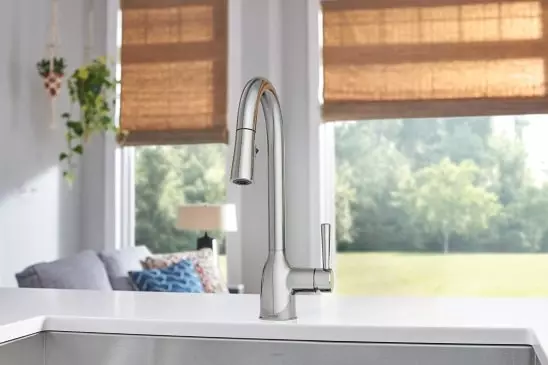How To Stabilize Kitchen Faucet?
Disclosure: Faucetshowerguide.com is reader-supported. We may receive commissions from purchases made via our links at no additional costs to you.
Sometimes plumbing problems seem big but their solutions are often quite easy. The unstable kitchen faucet is one of those problems.
Loose faucets hamper your daily cleaning tasks. It becomes annoying to use a loose kitchen faucet. You can’t set the handle at the required water pressure and it becomes difficult to pull the spray head. Also, loosening the faucet damage the plumbing of the sink.
One major reason for the unstable kitchen faucet is loosened nuts. If nuts are not properly tightened, a gap comes between the faucet base and countertop. It seems irritating and over time it damages the surrounding area.
Without delay, you should fix the loose kitchen faucet base. Don’t call the plumber every time to solve this type of tiny issue. In this guide, on how to stabilize kitchen faucets, we have described solutions in the detail. So, whenever you see a wobbly faucet, you can fix it yourself.

On Sale
Moen Arbor One-Handle Pulldown Kitchen Faucet
Moen’s exclusive Power Boost technology, clean and faster fill with the push of a button, Equipped with the Reflex system
Why Is My Kitchen Faucet Loose?
Loose Base Nut
The main reason for the unstable kitchen faucet is the loosened base nut of the sink faucet. The faucet base holds the faucet in its place.
Whether you have a new black faucet or an old one, its nut may loosen if it is not tightened properly at the time of installing the faucet. The nut under the sink holds the faucet base and its head together. Once nuts are loosened gap is created between the faucet base and head which results in an unstable faucet.
Damaged O-rings

If the faucet is unstable from the handle, damaged O-rings are the reason. O-rings are located inside the handle and move the handle smoothly. O-rings are made of plastic so over time they get damaged. This makes the handle unstable.
How To Stabilize Kitchen Faucet?
To stabilize the kitchen faucet, you don’t need to call a plumber. It is a simple DIY method. Without any hassle, you can do it easily.
Kitchen Faucet Tightening Tools
For every plumbing work, some tools are needed. To tighten a sink faucet to prevent its wobbling issue, you need some common tools that are easily available in your home.
How To Stabilize Kitchen Faucet Base?
To make the kitchen faucet base stable, you need to tighten the nut of the base that holds the base and head together. How to find a nut and how to tighten it, the whole process is described in the detail.
Step 1 – Use a Flashlight

This whole process is done under the sink cabinet. Generally, this cabinet doesn’t have much visibility so you have to use a flashlight. Light a flashlight into the cabinet so you get better visibility. Due to flashlights, it becomes easy to do plumbing tasks there.
Get Instant Solutions For Your Home Issues For Free - Chat With Experts
Get Paid For Your Opinion With Online Surveys - Start Earning
Step 2 – Clean Under Sink cabinet
Most people keep fewer used items under the sink cabinet. People use the under sink as a storage space to keep cleaning products. To tighten the nut, you need to go underneath the sink, so remove all products from there so you get enough space to do your work.
Remove dirt from the floor so your clothes won’t get dirty. Upper surface cleaning is also necessary. People forget to clean the upper surface and when you start stabilizing the kitchen faucet, dust may enter your eyes.
Step 3 – Turn off Water Supply

This is not an essential step but for precaution, you should do it. This will prevent any mishaps from happening. In case, any leakage occurs while tightening the nut, you don’t end up getting soaked all over. Find the shut-off valve and turn it off.
Step 4 – Locate The Nut
Now take a flashlight and start finding the nut. Maybe there is more than one nut that holds the faucet stable. Slide into the sink cabinet and look upward to see the nut.
Step 5 – Tighten The Nut
To tighten the nut, use a wrench. Adjust the size of the wrench according to the size of the nut. Make a firm grip of the wrench on the nut and rotate it clockwise. After a few rotations of the wrench, the nut will be tightened properly.
Check the faucet, if it is still wobbling, you need to tighten the nut. Nut tightening is a sensitive process. If you under-tighten the nut, the faucet stabilization issue will be not solved. You have to keep rotating the nut until you feel, you can’t rotate it anymore.
If you overtighten the nut, its grip will be finished and the nut starts slipping.
When the faucet is in the stable position, turn on the water and keep all the removed stuff under the sink cabinet.
How To Stabilize Kitchen Faucet Handle?
Another reason for unstable or wobbling modern kitchen sink faucets is the loose handle. After tightening the faucet base nut, the kitchen faucet is still wobbling, check its handle. Here are instructions to stabilize the kitchen sink faucet.
- Before starting the process, make sure that the water supply to the faucet is turned off.
- Now inspect the handle of the faucet.
- According to the faucet model, maybe the handle screw is visible or covered with a decorative tap.
- Use a screwdriver or wrench according to the type of faucet screw. Slide the screwdriver into the wrench.
- Now tighten the screw by rotating the screw in the clockwise direction.
Frequently Asked Questions
Why Does My Faucet Keep Getting Loose?
The main reason, the faucet keeps getting loose is the loosened nut. If nuts are not tightened properly, the faucet will show a stabilization problem. If the faucet is old, probably threads of the nut are removed so they loosen after some time. Change the nut to solve this issue.
How Do I Stabilize My Kitchen Faucet Handle?
Everyone wants a properly functioning faucet but when its handle does not work properly, you get irritated. In the kitchen faucet handle, there is a screw, you need to tighten it so the handle keeps remaining in a stable position.
How Do You Secure a Countertop Faucet?
If the countertop faucet is wobbling then there is an issue with its faucet base. The base is not tightened properly so the faucet wobbles. From underneath the sink, tighten the nut by using a wrench.
Final Words
The kitchen faucet is an everyday item. Every day many times, we turn it on or off. Due to heavy usage sometimes after a few years, the faucet starts wobbling. A wobble faucet is not good to use. For those who want to know how to stabilize kitchen faucets, this guide is written.

Meet Ralph Matthews, father of 2 cute daughters and a skilled plumber with over 10 years of experience in the industry. Ralph has particular expertise in repairing any type of faucet and has helped countless homeowners and businesses solve their plumbing problems with his expert knowledge and attention to detail.








